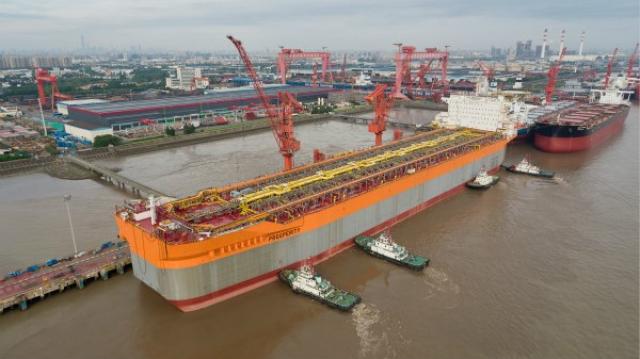
(Source: Shanghai Waigaoqiao Shipbuilding/Hess Corp.)
The Exxon Mobil Corp.-led Payara oilfield development offshore Guyana took a leap forward with partners agreeing to proceed with the $9 billion project.
The final investment decision announced by Exxon and Hess Corp. late Sept. 30 came after the Guyanese government gave the project the green light, paving the way for the third major development off the prolific Stabroek Block where recoverable resources are more than an estimated 8 billion boe.
The decision had been delayed as companies awaited the conclusion of a government review of the project following Guyana’s March election and the seating of new government officials in August.
“We thank the government of Guyana for their support and look forward to realizing the full potential of this world-class resource,” Hess CEO John Hess said in a statement. The company said its share of development costs, excluding the FPSO and pre-sanction expenses, will be about $1.8 billion.
Exxon and Hess, working with China’s CNOOC Ltd., plan to have 10 drill centers with up to 41 wells, including 20 production and 21 injection wells, at Payara. The development will target a resource base of about 600 million boe, Exxon said in a separate news release.
Analysts with Tudor, Pickering, Holt & Co. (TPH) noted that equates to about a $41,000 per flowing capital efficiency, compared to about $27,000 for the Liza Phase 2 development.
“The delta in build costs looks to stem from differences in necessary infrastructure spending,” TPH said in the note.
Hopes are for Payara to start production in 2024, utilizing the Prosperity FPSO, which is capable of producing up to 220,000 bbl/d of oil.
SBM Offshore was tapped to construct, install and then lease and operate Prosperity for up to two years, the company said. Ownership and operatorship of the FPSO—which SBM said will be spread moored in a water depth of about 1,900 m—would then transfer to Exxon subsidiary Esso Exploration and Production Guyana Ltd. (EEPGL). The vessel is similar to Liza Unity.
In addition, TechnipFMC said Oct. 1 it secured the contract to manufacture and deliver the subsea production system for Payara. The system comprises 41 enhanced vertical deepwater trees and tooling, six flexible risers and 10 manifolds with associated controls and tie-in equipment. The contract is valued between $500 million and $1 billion, TechnipFMC said.
When Prosperity joins Liza Destiny and Liza Unity in 2024, production capacity will rise to a total 560,000 bbl/d from the trio of FPSOs. Production from Liza Phase 1 started in late 2019, and Liza Phase 2 is on scheduled to mark first oil in early 2022.
More vessels could be on the horizon, considering 18 discoveries have been made on the block—enough for at least five FPSOs producing over 750,000 bbl/d by 2026, the companies have said.
News of the latest discovery, made at the Redtail-1 well, was delivered in September alongside word that 69 ft of net pay was hit in new reservoir intervals at the Yellowtail-1 discovery.
“We continue to prioritize high-potential prospects in close proximity to discoveries and maximize value for our partners, which includes the people of Guyana,” Liam Mallon, president of ExxonMobil Upstream Oil & Gas Co., said in a news release.
Among the discoveries being evaluated for development are Yellowtail, Redtail, Mako and Uaru.
Exxon Mobil announced the Payara discovery in 2017.
Holding a 45% interest in the 6.6 million-acre block, EEPGL is the operator. Partners Hess and CNOOC respectively hold 30% and 25% interest.
Recommended Reading
Eni Reports Discovery Offshore Mexico in Block 9
2024-07-10 - Italian energy giant Eni SpA announced a discovery at the Yopaat-1 EXP exploration well in the offshore Mexico Block 9 of the Cuenca Salina in the Sureste Basin, which potential up to 400 MMboe in place.
E&P Highlights: July 10, 2024
2024-07-10 - Here’s a roundup of the latest E&P headlines including TotalEnergies exiting South Africa to focus on opportunities in Namibia.
CNOOC’s Bohai Bay Well Achieves High Yield
2024-07-11 - CNOOC’s Bozhong 19-6 Condensate Gas Field D1 well, the first ultra-deep well in China’s Bohai Bay, is currently producing approximately 6,300 boe/d.
Goodbye Manual Control: Vital Energy’s Automation Program Boosts Production
2024-07-12 - Production, ESP efficiency soared when the company automated decisions with AI at the edge.
VAALCO Reports Increased Reserves After Svenska Deal
2024-07-16 - VAALCO acquired Swedish E&P Svenska’s 27.39% non-operated working interest in the deepwater Baobab Field in Block CI-40, offshore Côte d’Ivoire.






